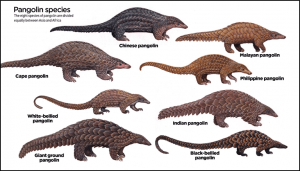Indian Pangolin:

A radio-tagged Indian pangolin was released into the wild in Nandankanan Zoological Park (Odisha) following soft release protocols and provision for post-release monitoring.
- Radio-tagging involves attaching a transmitter to an animal to monitor its movements.
- Several wild animals — tigers, leopards and migratory birds — have been tagged over decades.
- Pangolins are scaly anteater mammals and they have large, protective keratin scales covering their skin.
- They are the only known mammals with this feature.
- It uses these scales as armour to defend itself against predators by rolling into a ball when threatened.
- Insectivore- Pangolins are nocturnal, and their diet consists of mainly ants and termites, which they capture using their long tongues.
- Out of the eight species of pangolin, the Indian Pangolin (Manis crassicaudata) and the Chinese Pangolin (Manis pentadactyla) are found in India.
- Indian Pangolin is a large anteater covered by 11-13 rows of scales on the back.
- A terminal scale is also present on the lower side of the tail of the Indian Pangolin, which is absent in the Chinese Pangolin.
- Indian Pangolin is widely distributed in India, except the arid region, high Himalayas and the North-East.
- The species is also found in Bangladesh, Pakistan, Nepal and Sri Lanka.
- Chinese Pangolin is found in the Himalayan foothills in Eastern Nepal, Bhutan, Northern India, North-East Bangladesh and through Southern China.
- Threats to Pangolins in India:
- Hunting and poaching for local consumptive use (e.g. as a protein source and traditional medicine) and international trade for its meat and scales in East and South East Asian countries, particularly China and Vietnam.
- They are believed to be the world’s most trafficked mammal.
- Conservation Status:
- Wildlife Protection Act, 1972: Schedule I
- IUCN Red List: Endangered
- Chinese Pangolin is ‘critically endangered’
- CITES: Appendix I




